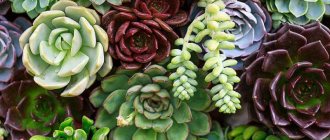- October 18, 2018
- Houseplants
- Natali Michaelis
The flower that will be discussed in today's publication is a very beautiful, perennial, decorative deciduous plant that belongs to the Marantaceae family. In its natural habitat, arrowroot, a photo of which is presented in the article, grows in tropical, swampy, forest areas in South and Central America. In Europe, this plant appeared only in the 16th century and was named after the famous botanist Bartolomeo Maranta. At that time he lived in Venice.
General description of arrowroot
These indoor plants can reach a height of 30 cm. The wide oval leaves are decorated with picturesque paintings. The length of the leaf plate is about 15 cm. Depending on the type and variety of arrowroot, a photo of which can be seen in this article, they have different colors, ranging from light green to almost black. There may also be pea-shaped spots on the leaves. The inside of the foliage may be blue, reddish or green. The photo with arrowroot shows that its petioles are short. In young specimens they point upward, but over time, if you do not provide them with additional support, the petioles spread. Small flowers begin to gather in inflorescences in the form of spikes or panicles.
Quite often, arrowroot is popularly called “Miranda flower” or “prayer plant” due to its unusual reaction to light. If the flower is dark indoors, or with the arrival of night, the foliage rises up, after which the outlet is completely closed. As the light gets brighter, the foliage unfolds again, taking a horizontal position. In science, this is explained by the fact that the leaf plates of this crop have special pads that are filled with water, due to which such turns are observed. In their natural habitat, Miranda flowers, photos of which are in this article, grow at the very bottom of dense forests. Therefore, they need to somehow receive at least a small amount of light through the crown of trees and bushes.
Interesting Facts
The name came from Italy, it was named after a physician from Venice, Bartalomeo Maranta.
Tricolor is called a prayer plant, its leaves seem to pray: they curl up when there is not enough light and unfold when morning comes.
The Indians knew about its healing properties; they made an antidote from its rhizomes to treat wounds from poisoned arrows.
The roots are still used today, but no longer in medicine. They produce a special type of arrowroot starch, which is used in cooking as a thickener.
Maranta is a tropical plant that prefers shade, warmth and moisture. If you provide all this at home, then it will delight its owner with bright, sophisticated colors. It looks good next to other indoor flowers, so it is successfully used in the design of offices and any other places. Problems during cultivation usually do not arise.
Arrowroot white-veined (or white-veined)
The homeland of this variety of arrowroot is Brazil. The plant has tuberous roots. The leaf blades have an elliptical shape. The leaves grow up to 15 cm long and up to 10 cm wide. The leaves are dark green on the outside and have a silver stripe in the center. There are light green patterns along the entire leaf blade, as well as white lateral veins.
The lower surface of the leaf blade may be reddish or blue-green. The petioles grow no more than 2 cm in length. These indoor flowers (arrowroots) can be found very rarely as a cultivated plant. In most cases, only its varieties are grown.
Varieties
There are more than 20 types of arrowroot, the most famous of which are:
- Arrowroot tricolor (tricolor or white-core). The length of the oval leaves is up to 13 cm, width – about 5-6. The upper side is decorated with veins and specks of contrasting color. The underside of the leaf is crimson with pink veins.
Maranta tricolor. The underside of the large oval leaves is crimson with pink veins
- Two-color. The leaves are oval-shaped with slightly wavy edges, their length can be up to 15 cm. The upper part of the leaves has a green color, as well as brown spots, the lower part is reddish.
Bicolor arrowroot leaves are lighter around the central vein and have brown spots on the upper side
- Arrowroot fascinator. The leaves are distinguished by a dark green upper side with light spots and bright red veins.
Beautiful, contrasting and rich colors, leaves of arrowroot fascinator
- Kerkhoven. This variety grows up to 1/4 m tall and has oval, dark green leaves with a white center vein.
Arrowroot Kerkhoven has some similarities with bicolor arrowroot, but the central part of its leaves is darker
The nature of the natural habitual growing conditions of arrowroot allows it to be kept outdoors outside the home during the warm season
Tricolor arrowroot
When looking at photos and names of arrowroot indoor plants, you should definitely mention the tricolor appearance. This crop has oval-shaped foliage that grows up to 30 cm in length. The width of the leaf plate reaches 6 cm. The main color of the velvety surface on the outer surface can be dark green or light green. It also shows distinct red veins and has yellowish-green or green spots in the center. A feather-like pattern can be seen on the sides.
The reverse surface of the leaf blade of this type of arrowroot has a crimson color, as well as pinkish veins. The flowers of this plant are light lilac in color. This species is popularly called the red ridge herring.
Popular types of indoor arrowroot plants
White-veined (arrowroot white-veined)
White-veined arrowroot is native to Brazil. It has tuberous roots. The foliage has a rounded-elliptical shape up to fifteen centimeters in length and up to ten in width. The outer surface is dark green in color, decorated in the center with a stripe with a silver tint, light green patterns run across the entire leaf blade, and the lateral veins are white.
The lower surface may be blue-green or reddish in color. Petioles are no more than two centimeters long. As a cultivated plant, white-veined arrowroot can rarely be found; its varieties are usually grown.
Tricolor (red-veined arrowroot, tricolor arrowroot)
Arrowroot tricolor has oval foliage up to thirteen centimeters in length and up to six in width. The main color of its outer velvety surface can vary from light green to dark green. Distinct red veins appear on it, light green or yellowish-green spots run along the central one, and a feather-like pattern along the sides.
As can be seen in the photo, the lower surface of the tricolor arrowroot foliage has a crimson color and pink veins. The flowers are usually light lilac in color. The common name of the tricolor arrowroot is quite strange, and sounds like a red backed herring. The varieties of the plant include an interesting variety of arrowroot, Fascinator.
Two-color (arrowroot bicolor)
Arrowroot bicolor is a less common plant. It has oval foliage that is slightly wavy at the edges and is up to fifteen centimeters long. Along the green top there are dark green and brown spots near the middle vein. The leaves below are pubescent and have a reddish color, as well as the petioles on which they are located. Unlike other varieties, bicolor arrowroot does not form tubers. The bicolor indoor arrowroot flower is also shown in the photo.
Kerkhoven
Kerkhoven's arrowroot is a low plant, no more than twenty-five centimeters. The oval foliage grows up to fifteen centimeters and has low petioles. On top it has a basic bright green color and a dark green or brown pattern in the form of peas or feathers.
There is a stripe of white color along the central vein. The bottom of the leaf may be red or blue. The white flowers are quite small and are collected in groups of two or three in small inflorescences. Apparently, Kerkhoven's arrowroot is popularly called a frog because of its color.
Two-color arrowroot
This type of plant is less common. The photo with the Miranda bicolor flower shows that the leaves have wavy edges, and they reach 15 cm in length. The leaf plate is green on top, with brown and dark green spots on the surface near the central vein. The leaves below are pubescent, reddish in color. Unlike other varieties, this arrowroot does not form tubers.
Reproduction
There are two types of arrowroot propagation:
- Separation when transplanting tubers.
In this case, a tuber with roots and several leaves is selected. Place in a prepared pot with moistened soil and cover with film for several days to maintain the required humidity.
- Cuttings.
At the beginning of summer, a small cutting with two to three leaves is cut from the tops of the shoots and placed in a container with water. Once the roots appear, it will be possible to plant them in a separate pot. In addition, pruning elongated shoots allows you to form the desired shape of the plant and also promotes the appearance of new leaves.
Maranta Kerkhoven
Photos of Kerkhoven's arrowroot flowers show that the plant is quite short, growing no more than 25 cm in height. The foliage is oval in shape and no more than 15 cm in length. The leaf blades are located on low petioles. The leaves are bright green on top and also have a brown or dark green pattern in the form of feathers or peas.
A white stripe runs along the central vein. The bottom of the leaf plate can be blue or red. The white flowers are quite small, collected several times in small inflorescences. Thanks to this unusual coloring, arrowroot is often called a frog.
Description
All representatives of the genus are low herbaceous perennials with tuberous roots and erect or creeping shoots.
On the shoots there are oval or lanceolate petioled leaves.
Leaves have different colors
The general background of the foliage varies from light shades to varying intensities of green. Veins and symmetrically located spots stand out on the surface of the leaf blade.
Maranta blooms at the end of spring. Its flowers are collected in an inflorescence of spikelets, rising on the flower arrow.
The petals of the corollas are painted in pale yellow, pink or white shades
However, the very fact of flowering of this plant is a significant event for flower growers, because Maranta blooms extremely rarely and only if it is kept comfortably.
Features of care
What is home care? The photo with arrowroot shows how attractive this plant can grow. However, it is worth paying attention to the fact that this crop is very capricious in care and cultivation. The homeland of this plant is the tropics, therefore, if the arrowroot is not provided with the appropriate conditions, it will not forgive any mistakes, as a result of which it will not be possible to grow a beautiful and healthy flower at home.
Above was a description of some varieties of arrowroot with photos. Caring for a plant at home requires compliance with certain rules, so you should carefully select the variety for breeding.
Useful qualities
Arrowroot flour is made from the tubers of the plant. This dietary product treats anemia and anorexia. It contains no proteins and fats, but is high in fiber and ash. The composition also includes folic acid, vitamins PP and B9, calcium. The product has a general strengthening effect, promoting:
- removing toxins from the body;
- lowering blood sugar;
- normalization of sleep;
- improving brain activity.
This natural thickener is an analogue of corn and potato starch and should definitely be included in the family diet. Contraindications for use include individual intolerance, stomach ulcers, and surgical interventions.
Maranta's photos demonstrate her stunning decorativeness, enlivening any interior with its beauty. In addition, there is an opinion that it suppresses negative energy, preventing quarrels and conflict situations in the family.
A non-trivial flower, the sign of Aquarius is the choice of creative, active people. It is a symbol of prosperity, and its flourishing promises monetary profit. In England, a pot with an outlandish bush is a mandatory attribute of virtually every home, called the “10 Commandments.”
Lighting rules
Arrowroot is a very shade-tolerant plant, so it should not be kept on southern windowsills. But if there is no other possibility, then it will be additionally necessary to create good shading. In bright light, the crop loses its decorative coloring, and the foliage decreases in size. The same will happen due to low light in the room, the lack of which can be easily determined by the leaves raised up. It should be noted that this flower responds positively to artificial lighting, for which fluorescent lamps are used. They must be used for 16 hours every day.
Content requirements
Caring for exotic flora representatives indoors requires knowledge of their individual characteristics. They love diffused light; direct sunlight, which causes burns, is extremely undesirable, so exotic plants are placed on western or eastern window sills.
They are often provided with artificial lighting using fluorescent lamps. Drafts and temperatures below +15 degrees, which guarantee death, are unacceptable. In summer, the temperature is maintained at +24.
Due to the horizontal development of the root system, plants require wide, shallow dishes with good drainage. They prefer light, breathable, slightly acidic soil containing:
- humus;
- peat;
- coniferous land;
- charcoal;
- sand.
Feed the flowers once every 14 days, using organic and mineral purchased fertilizers, applying them after watering.
Timely winter pruning to the root will provide the bushes with enviable splendor.
Air humidity and temperature
In order for the plant to be as beautiful as in the photo, the arrowroot flower must be kept in a room with an air temperature of 22-25 degrees in the summer. In winter, a period of rest begins, so the air temperature in the room drops to 15 degrees, not lower. You should also pay attention to the fact that sudden changes in temperature and drafts are dangerous for the flower (Miranda does not like this). Indoor air humidity should be quite high, being about 90%. It is for this reason that it is recommended to spray the leaves of the plant with clean water every day. But if there is lime in the water, the leaf blades may become covered with whitish spots. Maranta also prefers to take warm showers periodically. It is recommended to do this once a month.
Brief description of cultivation
- Bloom . Arrowroot is grown as an ornamental foliage plant.
- Illumination . Needs a lot of light, which should be diffused. You can also grow a flower under artificial light, but in this case the daylight hours should be 16 hours.
- Temperature regime . In summer - from 23 to 25 degrees, and the temperature of the soil mixture in the pot should be at least 18 degrees. From the second half of autumn until the last weeks of spring - from 18 to 20 degrees.
- Watering . In the spring-summer period, it is necessary to water abundantly, immediately after the top layer of the soil mixture dries out. In the cold season, watering should be moderate.
- Air humidity . Should be elevated. Throughout the year, the bush is moistened with lukewarm water from a spray bottle. To increase humidity, wet expanded clay is poured into the tray, and a flower pot is placed on it.
- Fertilizer . Fertilizing is carried out throughout the year once every 15 days; for this, organic matter and mineral fertilizers are alternately used in half the dosage.
- Rest period . Not clearly expressed.
- Transplant . The procedure is carried out once every 2 years in the first weeks of spring.
- Soil mixture . It should consist of garden soil, sand and peat (6:2:3).
- Reproduction . By dividing the bush and cuttings.
- Harmful insects . Spider mites.
- Diseases . A plant may lose its decorative value in unsuitable conditions or due to improper care.
Arrowroot tricolor. Planting and care.
Feeding and watering
The indoor arrowroot plant is watered only with well-settled water at room temperature. The soil in the pot should always be slightly moist during the summer and spring periods. With the arrival of winter, the soil should dry out between watering procedures. Insufficient humidity can be indicated by leaves that curl into a tube.
As for fertilizers, this indoor flower is fed from April to September. For this purpose, liquid complex mineral fertilizers are used. Feeding is carried out 2 times a month, and you should follow the clear instructions that are attached to the composition. It must be remembered that this crop is very sensitive to an excess of nutrients in the soil.
If in winter the arrowroot remains to grow under normal conditions, you need to fertilize it once a month. In addition, the fertilizer is diluted twice as weakly. But if the plant is in a dormant period, then in winter you should refuse to apply fertilizers.
Caring for arrowroot at home
Illumination
Arrowroot needs bright, but diffused light; it must be protected from direct rays of the sun. Therefore, it is recommended to place it on a window of eastern or western orientation. If the flower is regularly exposed to direct rays of the sun, then the adult leaf blades may lose their spectacular color, and the young ones may become smaller. If you cannot find a place with optimal lighting for a flower, then it is recommended to grow it under fluorescent lamps, and the duration of daylight in this case should be at least 16 hours.
Temperature
Such a flower can be harmed by both excessively high and low air temperatures. In summer, make sure that the air temperature is from 23 to 25 degrees, and do not allow the substrate in the pot to overcool (not lower than 18 degrees). From mid-autumn to early summer, the optimal air temperature for arrowroot is 18–20 degrees. It can withstand a temperature drop of up to 10 degrees, but if it is colder, the plant will die. Protect it from sudden changes in temperature during the day, as well as from drafts.
Watering
During the spring-summer period, watering should be plentiful, while making sure that water does not stagnate in the substrate, but the earth clod should not be allowed to dry out. In the cold season, watering is moderate; it is carried out immediately after the surface of the soil mixture in the pot dries. For irrigation, you need to use warm water, the temperature of which should be slightly higher than room temperature, because the root system reacts extremely negatively to hypothermia. It should also be soft and well-settled (at least 12 hours).
Air humidity
The flower needs high air humidity; therefore, it is moistened with settled soft water from a sprayer throughout the year. If the air humidity level is very low, then spraying should be carried out regularly in the morning and evening. And to increase humidity, place the container with the flower on a tray, which is filled with wet expanded clay or pebbles, while making sure that the bottom of the pot does not come into contact with the liquid. In the warm season, the plant can be given a warm shower, but remember that the substrate in the pot must be covered with film so that water does not get into it during the procedure. However, be prepared for the fact that even if all these conditions are met, the tops of the arrowroot leaf plates will dry out.
Fertilizer
Fertilizing is carried out systematically once every 2 weeks, for this they alternately use organic matter and mineral fertilizers (the concentration of the nutrient mixture should be 2-3 times less than recommended by the manufacturer).
Arrowroot transplant
Transplantation is carried out once every 2 years in the first weeks of spring. The container for planting is taken low and it is better if it is plastic, while its size should be slightly larger than the old one. At the bottom, a drainage layer is made of coarse sand and broken bricks (expanded clay). The substrate needed is slightly acidic. Its composition may include peat, sand and garden soil (3:2:6) or peat, humus and leaf soil (1:1:1). It is recommended to add a small amount of charcoal and pine soil to the prepared soil mixture.
Before you start replanting, you need to cut off all the dried and limp foliage from the bush, in this case the young shoots will develop more actively.
transplanting arrowroot tricolor
Reproduction methods
During spring transplantation, arrowroot can be propagated by dividing the bush. You can also use apical cuttings for these purposes. To transplant or plant a flower, you need to buy a substrate designed specifically for arrowroot crops.
The planting container should be wide, but shallow. It is best to choose plastic pots, which retain moisture much longer. There must be drainage holes at the bottom of the container, and there must also be a layer of drainage at the bottom. For this you can use crushed stone, pebbles, broken brick. This is necessary so that the water does not stagnate in the pot for a long time, otherwise the roots may begin to rot.
Transfer
Arrowroot is usually planted in plastic pots, since ceramic ones contribute to hypothermia of the tubers in winter. The pot itself should be wide enough. It is necessary to place drainage at the bottom, then use loose soil mixed with sand or peat.
It is recommended to do the first transplant after three years. Subsequently, the young plant is replanted in the spring every year, and then, if necessary, the flower pot is replaced with a more spacious one. But at least once every four years.
- Advantages of Gardena gardening equipment
Bathhouse made of 6x6 timber
- Ktenanta - types, cultivation characteristics and instructions for care at home. 110 photos of plants
Dividing the bush
To propagate arrowroot at home by dividing the bush, you need to remove the plant from the container and divide it into no more than 3 approximately equal parts. All species that have tubers must be a separate part. Those that do not have tubers should have several well-developed roots, as well as several leaves. All cuttings should be planted in separate containers, slightly moistened the soil and covered with a plastic bag on top. The air temperature in the room with seedlings should be about 20 degrees. Periodically, the cover must be removed to allow the plant to ventilate. In addition, the seedlings need to be sprayed and watered. When these plants take root, they must be removed completely.
Maranta at home: signs and superstitions
There are indoor plants around which there are many legends and superstitions. This includes arrowroot. It is believed that it can enrich the one to whom it belongs. It is recommended to place this flower in the kitchen or living room, where all family members usually visit.
Maranta is considered the keeper of family comfort. It normalizes a favorable aura in the house, brings peace and harmony to relationships between family members. This is a good helper in the fight against irritability, depression, and insomnia. If someone in the house is sick, it is advisable to place a flower near the bed at the head of the bed.
Arrowroot is a tropical crop that, thanks to its colorful foliage, has gained great popularity as a houseplant. Arrowroot cannot be called undemanding. To grow a lush shrub with colorful foliage, you need to pay enough attention to it and adhere to certain care rules.
Want to know more secrets of growing arrowroot at home? Watch the video below:
Apical cuttings
Rooted cuttings of the plant can be used for propagation. If the flower produces many long shoots, then they are cut so that they are at least 10 cm long, as well as several leaves with a node in the lower area. After this, they are planted in moist soil, which consists of equal amounts of sand and peat. The cuttings are covered with plastic wrap or glass jars, and then sent to a warm room. To do this, you can use mini-greenhouses where there will be high air humidity.
In addition, the cuttings can be placed in water, where a growth stimulator and activated carbon are added. As a rule, within a month and a half the cuttings will form roots. When their length is about 2.5 cm, the young plants are transplanted into the substrate; they should be provided with shelter and placed in a warm place.
Replanting and pruning
Arrowroot should be replanted every two years in the spring. To do this, you need to take a pot with a diameter not much larger than the one in which it grew. At the same time, dried and wilted foliage is cut off from it. In order for new shoots to grow better and the bush to be lush, you need to trim the root system a little and several cuttings with nodes that can be used for propagation.
If you prepare the soil for replanting yourself, you need to make sure that it does not contain lime, which has a detrimental effect on the condition of the arrowroot.
When replanting, there is no need to strongly compact the soil around the bush. In the first month after planting, you should not feed the plant, placing it in a shaded place without drafts or temperature changes. You can cover it with a plastic bag to retain moisture and better rooting, which needs to be removed periodically. After the formation and growth of new leaves begins, the arrowroot must be transferred to a permanent place of growth.
Young arrowroot has the most attractive appearance. Therefore, many experienced gardeners advise cutting it off completely every year , and within a month and a half after this it is restored, since it has a very strong root system and acquires its original appearance, and the leaves become more decorative and bright. You can also prune in the fall and send the plant to a dark place, watering it infrequently.
Possible diseases and pests
The most dangerous for this plant are mealybugs and spider mites. As a rule, they attack plants if the air humidity in the room is too low. As soon as these pests are detected, the flower must be treated with an insecticide-based solution, or you can also use folk remedies.
As for the disease, arrowroot can be affected by chlorosis. This disease is expressed in the form of reduced leaves, their falling and yellowing. At the same time, the tops of the shoots begin to dry out, after which the roots gradually die off. As a rule, this disease is caused by fungi and viruses, too low soil acidity, as well as a lack of nutrients in the substrate. First of all, it is necessary to identify the main cause of the development of diseases, after which water the arrowroot with water and an insecticide, and you can also add the missing fertilizer.
If water often gets on the leaf plates, various fungal infections may appear. As a rule, for this reason, small wet spots form on the leaves, after which the foliage turns yellow and necrosis begins to develop. In such a situation, it is necessary to treat the flower with a fungicide solution.
Varietal varieties of arrowroot
"Fascinator" (M. leuconeura Fascinator). or "Tricolor" (M. tricolor)
The most famous variety, referred to by sellers of potted plants as “tricolor”. Sometimes found in popular science publications about indoor floriculture, like red-veined arrowroot. Three colors are clearly visible on the leaf: a dark green velvet background in the middle of the leaf, light green along the edges and contrasting crimson veins. The leaf has a peculiar pattern - 10 dark spots that form the background. For this coloring, the plant is popularly called the “10 Commandments”, and for its peculiarity of turning its leaves towards the sun, raising or lowering them, as if “bowing” depending on the lighting, the flower is called “prayer grass”.
Many people see the ridge of a fish in the color of this arrowroot. The bush grows in width and height up to 30 cm, the stems do not stand straight, but seem to hang. The leaf petioles have an interesting growth - “along a broken line”. the flowers are small, light lilac.
"Massange" (M. leuconeura Massangeana)
It is classified as a “black” arrowroot due to the very dark color of the middle of the leaf blade. The pattern on the leaf is contrasting, consisting of a green background along the edges of the leaf; on the sides of the central silver vein, light green stripes of lateral veins protrude like an edge.
Between them are bright strokes of brownish-green color. The plant is very compact, miniature, only 15 cm in height. It is considered the most capricious arrowroot when it comes to care.
"Marisella" (M. leuconeura Marisela)
A very similar variety to M. "Massanzha". It has a darker green background. The jagged pattern is preserved only near the central vein; the lateral veins are almost invisible.
"Kerchoveana" (M. leuconeura Kerchoveana)
Tall and spreading plant. The leaves are elongated, elliptical in shape, 12-15 cm long, sitting on short petioles. Very bright color of the leaf plate: dark brown strokes and eyes are located on a bright green background.
The spots on the sheet are always clear and do not merge into a solid line. The bottom of the leaf is colored bluish and reddish. The height of the arrowroot is 25 cm. The flowers are small, inconspicuous, collected in groups of 2-3 flowers, pale lilac. The veins on the leaf are not raised and do not stand out in color. This unpretentious variety is often used in landscaping offices and institutions.
"Beauty Kim" (leuconeura Beauty Kim)
The leaves are smooth, heart-shaped or oval, with a pointed edge, and have viral variegation. The main background is light green, with dark green clearly traced spots. There are strokes and stripes of light green, pale yellow or white across the entire surface of the sheet.
Some leaves may be half white. All strokes, white spots and stripes are located along the central and lateral veins of the leaf. The veins themselves are poorly expressed.
"Emerald Beauty" (leuconeura Emerald Beauty)
It is similar in color to the “Beauty Kim” variety. The same viral variegation, but the pattern is very blurred, the background has no contrasts, there are no dark green spots. The leaves are very shiny, but from a distance they appear just green.
The arrowroot genus is not limited to these representatives and includes more than 20 species of tropical herbaceous plants. The listed species and their varieties have brightly colored leaves. The rest are botanical species that have not taken root on the windowsills of amateurs, perhaps due to difficult agricultural technology and the difficulty of getting a rare specimen.
https://komnatnie-rastenija.ru/maranta-uhod-i-razmnozhenie-v-domashnih-uslovijah-foto-vidov/https://glav-dacha.ru/bozhestvennye-vidy-maranty/https://greendom. biz/komnatnye-rasteniya/dekorativnolistnye/maranta/vidy-mar.html
Useful properties of arrowroot
And what does the arrowroot flower, the photo of which is in this article, bring into the house? It is believed that this flower combines Mercury and Mars with the Sun. That is why this plant has a very “hot character”. When located indoors, arrowroot creates protection against various colds and other diseases that are caused by hypothermia. In addition, the powerful energy of this culture calms the nervous system, normalizes sleep, and also dissolves blood clots in blood vessels.
The bright Sun is responsible for leadership and creativity. Energetic Mars is responsible for increasing activity. Mercury is for connecting people. That is why arrowroot is able to neutralize negative and aggressive energy in the house, as well as remove a tense environment and eliminate conflict situations and frequent quarrels indoors.
Many believe that this culture improves the ability to communicate, learn and do business. If a person grows this plant at home, then he can easily make the necessary contacts, study complex sciences, and also quickly make a profit from any projects or favorite activities. Thus, arrowroot helps improve your financial situation. In addition, gardeners who grow flowers at home are less grumpy, fussy and more silent.
You should pay attention to the fact that cats love to feast on this plant. However, you should not be afraid of this, since the culture does not pose any danger to these pets, because the flower is non-poisonous.
If the leaves begin to turn yellow and dry out, this indicates that the air in the room is too dry. In this case, you need to put expanded clay or moss in the tray and moisten it first. You should also increase the number of spraying procedures for the flower itself, as well as the space around it. In addition, arrowroot may turn yellow due to waterlogged soil. In such a situation, it is necessary to reduce the frequency of watering.
Atmosphere
We must try to bring the tropics into the apartment. She is not comfortable in dry air during the heating season.
It is necessary to continue spraying it, do not interrupt such care in the winter, spraying can be alternated with watering, and in the summer you can use both.
Sometimes this is not enough. Then you need to leave the pot in a tray filled with soaked moss mixed with expanded clay for the whole night.
Sometimes give the flower a warm shower, but be sure to cover the soil with a thick bag to avoid waterlogging.
Growing problems
- The ends of the leaves are brown and dry, slow growth is a possible reason: the air is too dry or the plant is too dry. Another reason is the quality of the water (lots of salts, chlorine, fluorine, hardness). Also check if the plant is affected by spider mites. Remove dead leaves and maintain humidity above 50%.
- The ends of the leaves are yellow-brown - with an excess or lack of nutrients in the soil. You shouldn’t get carried away with fertilizers, especially if you have good quality soil. At the same time, depleted plants have pale, small leaves, and require replanting rather than feeding.
- The leaves curl, the lower leaves turn yellow - a possible reason: insufficient watering. The soil should not dry out too much, especially if the temperature is above 26°C.
- Sluggish stems, drooping shoots - if it is too cold and/or the soil is damp for a long time.
- Leaves lose color, turn pale, discolored and dry out - when sunlight is too intense, when the afternoon sun hits the leaves, or when attacked by mites.











